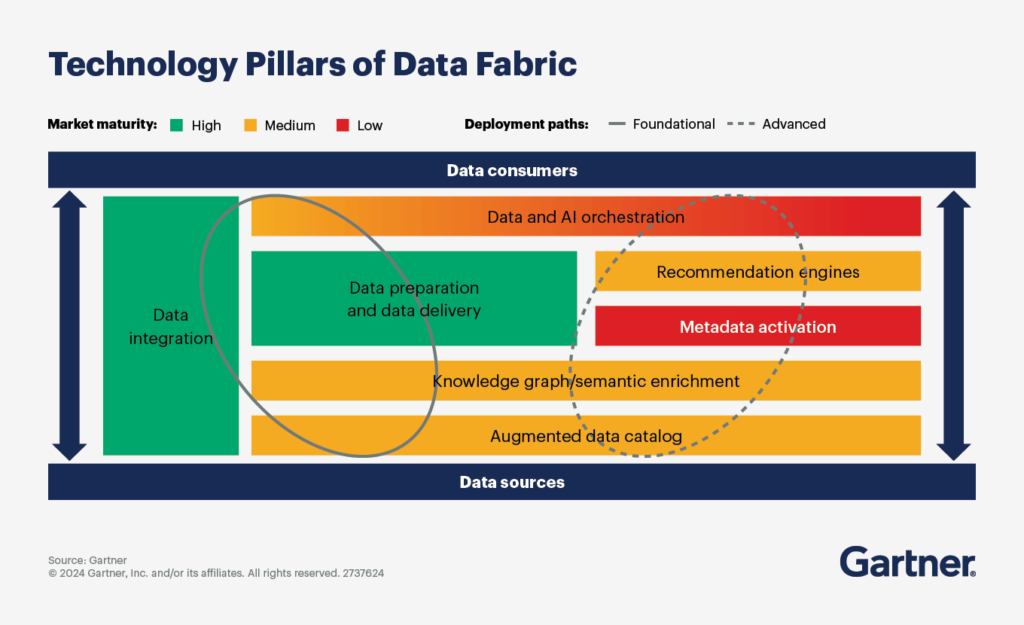
How Data Leaders Can Harness GenAI for Decision Intelligence Augmentation
Think it’s humans vs machines? Let’s reframe that debate.
It starts with a PowerPoint.
Slide after slide is packed with colorful charts and metrics. Numbers flying. The room buzzes with talk of “market trends” and “customer behavior.” It feels like a decision goldmine
Until someone asks, “What do we actually do with this?” (cue the awkward silence). Suddenly, the goldmine becomes quicksand. The conversation halts. Glazed eyes look around in confusion…
Yes, data is everywhere, but clarity? That’s rare. And so, the question isn’t ‘How much data do we have?’ It’s ‘How do we make sense of it?’
What is Decision Intelligence Augmentation?
What’s missing from your GenAI strategy? A partnership between GenAI and human judgment.
Decision intelligence augmentation sits at the crossroads of GenAI and human judgment. It’s the sweet spot between decision support and automation. It’s a partnership. GenAI does the grunt work. Humans keep control. Gartner calls it the perfect balance.
GenAI cuts through the data noise to deliver all the data you need, nothing more than the data you need, and customizes it to your business context. It maps trends, connects dots, and highlights patterns so you can focus on making the right call.
But most organizations aren’t ready. Gartner found that 41% of enterprises lack confidence in their data or GenAI’s reliability.
With data silos, clashing metadata and semantics, governance gaps, and inconsistent ontologies lurking in the shadows, the promises of GenAI can quickly morph into pitfalls.
Decision intelligence augmentation is both your shield and your magic wand. It’s the process of combining GenAI’s speed and precision with human judgment, creativity, and strategy to support data-backed decision-making.
“Envision a decision-making process informed by data actively supported by GenAI that can consider countless variables, predict outcomes, and even suggest innovative solutions.
This future combines the power of advanced analytics and machine learning with human expertise to drive better, faster, and more consistent decisions across the organization.”
—David Pidsley, Gartner
Why Augmenting Decision Intelligence Matters
What is the current state of data-backed decisions in businesses? Most decisions still aren’t made with data.
A recent BARC survey saw 58% of respondents say their companies base at least 50% of their business decisions on intuition rather than data.
Percentage of regular business decisions that are more based on gut feelings than on data (n=697). Source: BARC.
It’s mind-boggling. Organizations are swimming—no, drowning—in data.
Data isn’t scarce. If anything, there’s too much of it. Data stacks are bursting. Analytics tools are everywhere. Yet, somehow, we’re still making strategic decisions based on a gut feeling. That’s a massive disconnect.
On the other side of this is a lot of talk of decision automation through GenAI. But even when you’ve got perfect, AI-ready data for your GenAI (while that’s great), it’s not enough to automate business decisions. Why? Because people change. Strategies change. Stakeholders change. You need the human element in the equation.
Real Decision-Making Needs Collaboration
Making a decision is not handing over the keys to GenAI and stepping back. It’s letting the GenAI do the heavy lifting: crunching numbers, running predictions, and offering the right data. At the same time, humans bring their judgment, creativity, and flexibility to the table.
As Gartner’s David Pidsley puts it:
“Envision a decision-making process informed by data actively supported by GenAI that can consider countless variables, predict outcomes, and even suggest innovative solutions.
This future combines the power of advanced analytics and machine learning with human expertise to drive better, faster, and more consistent decisions across the organization.”
The future isn’t humans vs. machines. It’s about us working together to make smart decisions faster.
Inna Tokarev Sela, CEO of illumex, breaks it down perfectly in the Who’s Your Data podcast:
“The real power of GenAI isn’t in replacing humans. It’s in working alongside us. At illumex, we’ve seen that when GenAI takes care of the grind, the tedious mapping, labeling, and analyzing, people are free to focus on strategy, creativity, and judgment. That’s where the magic happens.
Having AI-ready data is not enough. You need data that’s meaningful, context-rich, and built to evolve with your organization. GenAI and humans are at their best when they collaborate and bring together precision and intuition to make better decisions faster.”
The first step to get there is to understand the false promise of data and AI literacy. So, let’s dig into that.
The Dark Side of Data Literacy and AI Literacy
Data literacy isn’t a new concept. It’s about clearly communicating what data you need and how you’ll use it. But there is a catch. It creates friction.
When people aren’t data experts, they hesitate. They’re unsure how to use data (and what data to use in the first place), let alone trust it. That’s one reason why only 25% of organizations are making most of their decisions based on data, according to a recent MIT Sloan survey.
The same challenges show up with GenAI and “AI literacy.” There’s a growing push to teach employees how to use GenAI properly. How to prompt, what to ask, etc. It sounds helpful, and it is. To a point. But it also shifts the responsibility onto the user. If a GenAI model gets it wrong, the blame lands squarely on the person asking the question.
- “You should’ve prompted better.”
- “You shouldn’t have asked that.”
And just like that, fear creeps in. Hesitation follows.
Users second-guess themselves, then the tools, then the process. They stop using the very systems designed to help them. And when people avoid the tools, the potential of data and GenAI withers.
How practical is it, really, to make people learn the language of data or GenAI? After all, these are the tools that came with the promise of making their jobs easier, not more complicated.
Data and GenAI should be intuitive and adapt to how people think, talk, and work. Not the other way around.
Let the system handle the complexity. Let it do the heavy lifting. So that data users don’t have to worry about prompts or technical accuracy. When users trust that their tools deliver clear, accurate, and context-aware information, they can stop worrying and focus on outcomes.
How Humans and GenAI Collaborate
So, how does this partnership work? Gartner’s Human-AI Delegation Framework lays out three levels of collaboration between humans and AI:
- Decision Support: AI plays the role of data assistant, organizing raw materials for humans to analyze. Humans still handle the heavy lifting of decision-making.
- Decision Augmentation: AI takes things further. It analyzes data, recommends actions, and leaves humans in control to validate and adapt. Think of it as teamwork.
- Decision Automation: The most hands-off approach. AI makes decisions with minimal human involvement and steps in only for exceptions.
Why does decision augmentation stand out?
Because it’s the perfect mix of practicality and precision for high-stakes environments. AI takes on the heavy lifting (managing the overwhelming flood of data) while humans step in with judgment and strategy. It’s where efficiency meets adaptability. It’s the best of both worlds.
But let’s dig deeper.
Efficiency as the Obvious Advantage
GenAI processes data faster, scales easily, and slashes time-wasting manual tasks. But adaptability is just as critical, and it’s often ignored. Why? Because everything in an organization is in flux:
- Businesses evolve. Strategies pivot. Priorities shift.
- Stakeholders change. Decision-makers, partners, and customer needs are always on the move.
- Data doesn’t stand still. It’s constantly generated, updated, and reshaped by new inputs. And metadata, the context around data, evolves just as quickly.
This is the reality. Data is a dynamic entity, not a static resource. With GenAI in the picture, where systems work at lightning speed, that dynamic nature makes changes speed up.
Most people think unstructured data is the biggest hurdle to deploying enterprise GenAI. And it’s easy to see why. After all, it’s about 80% of organizational data.
But the real decision-making power lies in structured data. And despite its name, making it usable isn’t so straightforward.
Traditional Analytics Won’t Cut It
Old-school analytics weren’t built for this. They’re static. Monolithic. Designed for environments where change was gradual, not constant. These models can’t keep up with the rapid-fire demands of GenAI applications. They aren’t scalable. Not for GenAI and not for sustainable business growth.
Adaptability Bridges the Gap
Adaptability is crucial. It makes sure that as data, strategies, and goals change, the decision-making framework can shift with them. It’s about having the flexibility to pivot without breaking. To scale without collapsing. And to interpret new information without hesitation.
In decision intelligence augmentation, adaptability shines:
- GenAI keeps up with ongoing inputs, continuously updating and refining responses.
- Humans make sure that business decisions align with changing goals, business considerations, and long-term strategies.
Together, it’s a system that thrives on change rather than fights against it. And to do it well, it must rely on AI-ready, well-governed data.
The Barriers to Enterprise GenAI Success
Most people think unstructured data is the biggest hurdle to deploying enterprise GenAI. And it’s easy to see why. After all, it’s about 80% of organizational data. But the real decision-making power lies in structured data.
And despite its name, making it usable isn’t so straightforward.
For structured data to truly work with GenAI, it takes more than organizing information into tables and fields. It needs to be semantically coherent, contextualized, and continuously governed.
Let’s take a closer look at the challenges of making structured data AI-ready:
1. Lack of Semantic Meaning
Structured data is often stored in tables and columns without context and meaning. Sure, it’s organized, in a way. But it’s also missing semantics, key relationships, and business usage context. GenAI models thrive on understanding how data entities connect. But, without semantic meaning and proper industry context, the results can go haywire.
Skewed or nonsensical outputs (yes, we’re talking AI hallucinations) can derail data-based business decisions. For example, if data isn’t labeled to reflect real-world relationships, like which customer belongs to which transaction, GenAI might make some (dangerously) inaccurate leaps.
More than 80 percent of AI projects fail.
That’s actually twice the rate of failure for information technology projects that do not involve AI.
2. Data Silos and Accessibility Issues
Most structured data lives in isolated systems. Different departments, applications, or even teams treat their data as their own. This creates silos that make it hard for GenAI to understand the full picture.
Without full accessibility, GenAI can’t deliver reliable answers. Worse, silos increase the risk of compliance issues, especially if sensitive data like Personally Identifiable Information (PII) is tucked away and overlooked during analysis.
3. Data Quality and Consistency
Truth is, messy data equals messy GenAI. Inconsistent or poorly maintained structured data can mislead GenAI and lead to inaccurate answers.
Take duplications, for example. If several different data entities are labeled with the same semantic tag, GenAI won’t know which one to prioritize. This will result in confusion and misaligned responses that can undermine trust in the system.
4. Governance and Compliance
Structured data often contains sensitive information, like PII. Managing those is a regulatory obligation, particularly sensitive in highly regulated industries like finance or healthcare. And most GenAI models don’t have inherent governance, so that’s on you to keep track of.
Without augmented governance that automates 90% of manual work, the risks skyrocket. Data that isn’t properly monitored and governed can lead to violations, hefty fines, and reputational damage.
Governance must also be built into every GenAI interaction to keep responses explainable, transparent, and easy to trust.
Trust is the Elephant In the Room
GenAI systems often feel like mysterious black boxes, spitting out answers without a clear explanation of how they got there. This lack of transparency leads to two major problems:
- Skepticism: Decision-makers hesitate to trust GenAI outputs because they question their reliability.
- Abandoned Projects: Poor data quality and lack of transparency block progress and stop GenAI initiatives in their tracks.
It raises a sobering question: Are we trying to run before we’ve learned how to walk?
The results speak for themselves. More than 80 percent of AI projects fail. That’s actually twice the rate of failure for information technology projects that do not involve AI.
Why Solving These Challenges Matters
Structured data might not be easy to work with, but it’s a goldmine for business decisions. Companies that figure out how to ongoingly map, semantically label, reconcile, and govern their structured data at scale gain a critical edge.
Having AI-ready data makes GenAI applications work the way they should, delivering on the promise of their potential. With proper governance and AI-ready data, your GenAI can give you accurate answers that will help drive smart business decisions.
Three events. Three chances to change the game.
And we’ll be there, ready to show you how to bulletproof your data and GenAI strategy.
Miss it? Your competition won’t.
➡ Tired of fighting data confusion and playing catch-up with governance?
➡ Want GenAI that doesn’t hallucinate and is inherently governed?
➡ Looking to improve your AI project’s cost of success (and cut 80% of your token fees)?
Find us at these two events, and let’s chat!
🗓️ March 3-5, Orlando, FL: The Gartner Data & Analytics Summit. [BOOTH 1106]
🗓️ March 10-13, Las Vegas, NV: HumanX AI Conference
🗓️ March 17-21, San Jose, CA: The NVIDIA GTC AI Conference. [BOOTH 2010]
Imagine your data, always AI-ready. Governance that runs itself. Responses from GenAI that are accurate, governed, and explainable.
It’s all possible, and we can show you how. See you there!
How to Achieve Responsible GenAI-Augmented Decisions
So, how can GenAI become your trusted assistant instead of a risky gamble?
For GenAI to empower decision-making, it must rest on a solid foundation of trust, transparency, and alignment. Here’s how organizations can make that happen:
1. Governance Embedded into Every GenAI Interaction
Think of governance as the backbone of responsible GenAI. Every interaction, whether it’s revealing specific data or suggesting actions, must align with your policies, business standards, and compliance requirements.
So you need to dot your i’s and cross your t’s and make sure your GenAI-generated answers are:
- Explainable: Easy to understand and validate.
- Traceable: Backed by clear data lineage.
- Auditable: Ready for regulatory and ethical scrutiny.
When governance is weaved into GenAI workflows, you build trust by preventing hallucinations, safeguarding sensitive data, and keeping every interaction transparent, governed, and explainable.
2. Semantics and Knowledge Graphs: Aligning Data Across Silos
Data silos breed inefficiencies, confusion, and missed opportunities. A semantic layer paired with knowledge graphs can bridge these gaps. It aligns data definitions across teams, systems, and strategies. Such harmonized data keeps GenAI outputs sharp, consistent, and relevant.
For example, instead of debating what “customer churn” means across departments, your semantic layer acts as a universal translator. It unifies semantics and definitions, reconciles metrics, and delivers consistent, actionable data to fuel smarter decisions.
One easy way to achieve this is through Generative Semantic Fabric (GSF), which combines knowledge graphs and semantic models and automatically maps and aligns (meta)data to your business logic. GSF makes sure your GenAI responses are accurate and aligned with your specific industry knowledge and strategic goals.

Knowledge graphs and semantic enrichment, as well as active metadata are key technology pillars of an organizational data fabric. Source: Gartner.
3. Active Metadata Management (Context is King)
Metadata is the unsung hero of GenAI. It’s the data about your data, providing critical details like what the data means, where it comes from, and how it’s used. But manually-managed, or disorganized metadata creates bottlenecks.
Active metadata transforms your organization’s metadata into a dynamic, ongoingly updated asset. Unlike static metadata, active metadata adapts in real time, and keeps on enriching your GenAI workflows with context and meaning.
With active metadata, you can:
- Trace data from source to decision and maintain reliability.
- Spot inefficiencies or bottlenecks in real time.
- Adapt workflows automatically as priorities shift.
This flexibility boosts accuracy to help you make smart business decisions.
Generative Semantic Fabric (GSF) architecture includes active metadata, knowledge graphs and semantic embeddings.
4. Weaving It All Together with Generative Semantic Fabric
Generative Semantic Fabric (GSF) ties these solutions together through a framework designed to unify and automate data governance, semantic alignment, and active metadata management.
What is GSF? The Generative Semantic Fabric is a dynamic layer that transforms raw, fragmented structured (meta)data into meaningful, context-rich business language. It gives your data a voice and purpose. Here’s what it does for you:
- Maps and aligns semantics: GSF guarantees data scattered across departments and systems speaks the same language—yours. No need to move data around.
- Embeds governance: Explainability, transparency, and compliance are baked in, not bolted on. GSF handles it behind the scenes, keeping every workflow trustworthy.
- Activates metadata: GSF turns your metadata into actionable, real-time context for GenAI workflows and updates it automatically as it goes along.
- Integrating domain-specific ontologies: Your business isn’t generic, and neither is your data. GSF is trained on domain-specific ontologies tailored to your industry and operations. This helps to make sure your GenAI truly understands your unique business and environment.
With GSF, your GenAI becomes a true business specialist thanks to:
- Contextual understanding: It makes sure your GenAI outputs are accurate and reflect the specific semantics, relationships, and nuances of your business.
- Scalable governance: Regulatory compliance? Sensitive data handling? GSF takes care of these at scale. So that every interaction meets your business’s standards.
- Dynamic adaptation: Business needs shift. Data evolves. GSF evolves with them, keeping workflows relevant and GenAI stays accurate and hallucination-free.
- Precision via ontologies: Each industry has its own jargon and internal logic which is why GSF is trained on domain-specific ontologies. Then, GSF automatically retrains on your business’s specific knowledge to make things even more precise.
The architecture of Generative Semantic Fabric by illumex
Why Does GSF Matter?
The Generative Semantic Fabric closes the gap between raw data and data-based strategic decisions. Without it, GenAI stumbles and often gives you irrelevant, unreliable, and outright wrong answers.
GSF aligns your data, keeps it governed and compliant, and gives your GenAI the context it needs to remain accurate. With domain-specific ontologies, it goes even further and makes sure your GenAI is fluent in your industry.
GSF makes your data work for you. And that changes everything.
Ready to Make Decisions That Actually Stick?
Data isn’t the problem. It’s the missed connections, the fragmented definitions, the GenAI “hallucinations” that leave your team staring at the same data but seeing entirely different stories.
But decisions shouldn’t feel like a gamble. They should feel like momentum. Governance, clarity, action. All working together, not fighting for the spotlight.
Because your data is actually your secret weapon. And with illumex’s Generative Semantic Fabric, every byte gets purpose. Governance becomes second nature. Semantics come together with precision. Metadata stops hiding and starts guiding.
No fluff, no guesswork, no wasted time. And 80% less manual effort.
Smart decisions don’t just happen. They’re built. Let’s build yours.
Contact us to see what illumex can do for your data and GenAI strategy!




